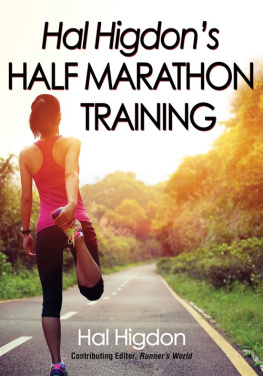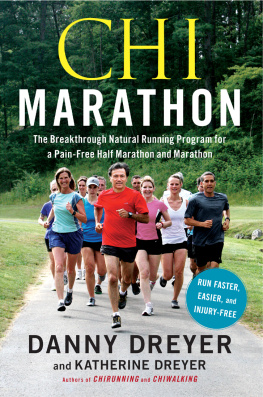THE MARATHON METHOD
The 16-week Training Program That Prepares You
to Finish a Full or Half Marathon in Your Best Time
TOM HOLLAND
Foreword by Jeff Galloway

DEDICATION
This book is dedicated to my son Tommy. I look forward to running many miles and many marathons with you in the years to come.
Text 2007 by Tom Holland
First published in the USA in 2007 by
Fair Winds Press, a member of
Quayside Publishing Group
33 Commercial Street
Gloucester, MA 01930
All rights reserved. No part of this book may be reproduced or utilized, in any form or by any means, electronic or mechanical, without prior permission in writing from the publisher.
11 10 09 08 07 1 2 3 4 5
ISBN-13: 978-1-59233-259-5
ISBN-10: 1-59233-259-5
Digital edition: 978-1-61673-425-1
Library of Congress Cataloging-in-Publication Data available
Cover design by Poul Lange
Book design and layout by Leslie Haimes
Photography by Paul Johnson Photography ( www.pauljohnsonphotography.com )
Printed and bound in USA

FOREWORD
Todays marathoner is running against the lifestyle grain of society. While most citizens are becoming fatter and more sedentary, a growing number of former couch sitters have decided to test themselves by training for the most arduous event in the Olympic Games.
It seems that marathoners have always been perceived as differentand not always in a good way. In the early 1900s, journalists regularly warned potential Boston Marathon spectators that the event was so far beyond the capabilities of a normal human being that they might see someone die during the race. During the 1960s, when I started marathoning, there were other popular leisure-time addictions. Marathoners were often described as an eclectic mix of eccentrics. Since I was one, Id have to admit that the description wasnt far off.
Today, there remain few significant challenges that must be done entirely by the individual. As Ive listened to tens of thousands of people refer to the magic of crossing the finish line, I have heard extremely accomplished people say over and over again that completing a marathon is their most meaningful achievement. Others have related how the boost to body, mind, and spirit allowed them to change their lives in a positive direction.
Tom Holland has done a terrific job of bringing together the elements that can lead to marathon success. His advice comes from substantial experience and the lessons learned from making mistakes. If you absorb the information he offers and heed his advice, you may well avoid the problems that I hear about every day from participants in my running schools, retreats, and e-coaching practice. Tom and I agree that the marathon finish is entirely possible for most of us.
Having helped more than 100,000 marathoners reach their goals, I believe that marathon training doesnt have to hurt or result in injury. With the right ratio of running and walk breaks, virtually everyone can gain control over the training process and enjoy most or all of the activities that he or she would normally engage in.
Even after a steady increase in the number of marathoners over the past twenty years, finishing a 26.2-mile event puts you in an elite categoryonly one-tenth of 1 percent of the population completes a marathon each year.
You can do it!
Jeff Galloway
United States Olympian
www.JeffGalloway.com
Introduction
I come from a family of six boys, no girls, and Im pretty sure my father took up running first and foremost to preserve what was left of his sanity. The amount of controlled chaos at home was probably directly proportional to the distances my father ran, so before long he was running marathons. Lots of them.
MY FIRST MARATHON
Like most runners, he would run longer on weekends, when he had more time. At the age of nine, I began to accompany him on his long slow distance or LSD runs, pedaling my little yellow bike with the banana seat alongside him as he put in the miles. We lived in a hilly town, and my dad would have to push me from behind to help me summit what seemed like unending peaks to my nine-year-old eyes and tiny quads. Im sure that this was quality hill training for him and that he benefited from the added workload. He owes me.
When I was ten, my father entered me in my first organized race. Five kilometers, 3.1 miles sheer heaven. We didnt run together, and I ran it like a Labrador that has been let out to run in a wide open field on a warm summers day. No warm-up, no pacing, just off like a rocket. My father was waiting for me as I staggered across the finish line, all sweat and smiles. I accepted my wooden Popsicle stick with my finishing place written on it from the volunteer, and from that day forward I was hooked.
So I continued to run races with my father as the years went on, but as I grew older these shared experiences became less and less frequent. My dad kept running, but I became involved with other sports and girls (and not necessarily in that order). I attended Boston College and, although I still exercised, it was primarily for vanitys sake and not for health.
Boston is home to the prestigious Boston Marathon, which is scheduled on Patriots Day, a holiday in Massachusetts, and the entire state seems to turn out to cheer on the runners. For several years, I lived on Commonwealth Avenue, which is part of the marathon course, right after the infamous Heartbreak Hill. We college kids would stand outside all day, swilling cheap beer and watching the runners swarm by, bragging about how we could all do it and placing bets on how we would absolutely do it the next year. This happened every April, but everyone had their excuses come January as to why he or she couldnt run that year.
My father continued to run marathons while I enjoyed college life. During my senior year, while home on Christmas break, he said he had a bib number for me and I could run the marathon with him if I so desired. This was a big deal, because the Boston Marathon is essentially by invitation only. You need to run a certain qualifying time based on your age in order to participate. (A chart with the current Boston Marathon qualifying times can be found on page 57.) A small number of people run as bandits, unofficial runners who begin at the back of the pack and do not receive finisher medals or finishing times. Bandits are usually college kids, guys running dressed as Elvis or wearing Superman costumes, and others who just want to be a part of the race but fail to qualify.
So I took him up on the offer. I was going to run my first marathon in Boston that April.
Now you must realize that I had no plan, no coach, no training schedule, and no book like this to help tailor my preparation. I also had no clue what I was getting into. I was both naive and arrogant. I had seen the body types running by me down Commonwealth Avenue year after year, and most of them looked much more out of shape than I was. I could do this; no problem.
I did have my father, however. I had seen what he did to prepare for his marathons and had accompanied him on my bike for his longer workouts. I knew that I had to run a couple of times during the week and then run longer on the weekends. Occasionally, my dad would call me at school to check on my training.



















